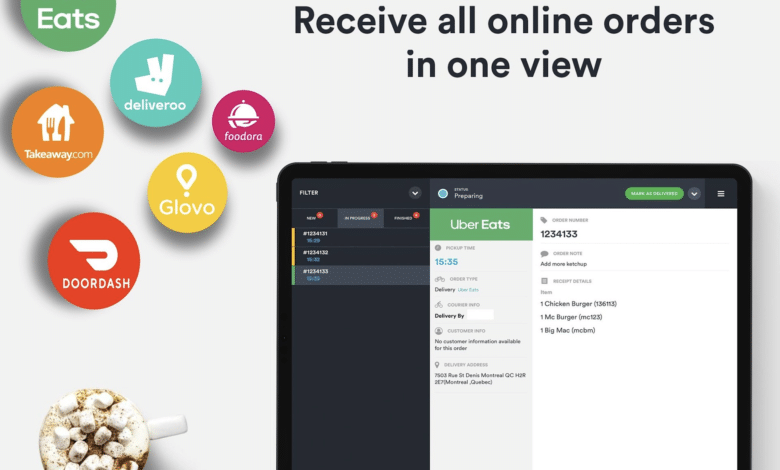
“The restaurant industry is experiencing a transformation.”
It’s no surprise that the transformation is happening. In many sectors – retail, travel, banking digital transactions have become the rule, and not the exception, making it increasingly easier for consumers to order products online.
Over the past few years, online food delivery has become one of the largest segments in hospitality, with delivery services like Uber Eats, Just Eat, and Deliveroo winning over consumers.
COVID-19 has propelled the industry years into the future, as millions of people in lockdown across the globe started ordering more food online. But while this surge in demand is starting to settle now that the world is opening up again, online ordering and food delivery won’t be slowing down. In fact, just the opposite will happen.
Today’s consumers want food on-demand, wherever they are, whenever they feel like it. That means, restaurants and other food services must leverage technology to serve their online customers and create a personalised experience to stand out from their competitors. Otherwise, they simply won’t survive.
So what can be done? First off, ask yourself what the key challenges you’re facing are when keeping customers happy and coming back for more.
Time and Resources
Digitally transforming end-to-end restaurant operations
Working with multiple third-party food ordering players is a smart strategy to scale up your business. However, each delivery service your restaurant works with will send you their own device, usually a tablet, with platform-specific software that typically doesn’t integrate with a restaurant’s EPOS.
This means if you’re on 4 platforms, you’ll have 4 tablets, on top of your own hardware. For dark kitchens or restaurants with multiple virtual brands, it’s even worse. Some run as many as 10 virtual brands on 5 different delivery platforms. That’s 50 tablets! It’s no wonder restaurants have coined the phrase “tablet hell” to describe the chaos that inevitably enters the restaurant when managing all these different devices.
Without an integration between the delivery platforms and the EPOS, restaurants must manually process online orders, creating inefficiencies and increasing error rates. They manually accept delivery and take-out orders on the aggregators’ tablets, and enter them in the POS system by hand. Double punching orders creates a delay in the kitchen, not to mention the online order tickets all look different based on the delivery service’s specific ticket layout. Enter confusion – and on top of that, even slower delivery times.
Rekeying orders is also prone to error. Naturally there will be mistakes and these order errors will lead to customer complaints, frustration, wasted food, and loss of revenue and repeat business.
Another key challenge for restaurants with multiple online channels is making updates to menus on each and every one of the tablets. Creating online menus on different third-party platforms and keeping them up to date can take up hours. Once you want to adjust a price or item, you would have to change it individually with each delivery service, making it hard to stay agile and make quick menu changes.
Loss of Revenue
Customers can order out-of-stock items because your stock isn’t synced with your online channels
Replenishing your inventory can be a complicated job if your stock isn’t automatically updated in your restaurant inventory software or POS system after an order has been placed online. When a customer orders an out-of-stock dish online you then have to contact them to cancel, which creates a “bad taste” with consumers, ending in unnecessary loss of revenue from individuals not coming back.
Customers don’t find your restaurant in the app
Cities like London, Madrid, Amsterdam, Dubai and New York count thousands of eateries with a delivery service. With many of those eateries signed up to platforms like Uber Eats, Postmates, Talabat and Deliveroo, the number of in-app restaurant listings, and thus competition, is huge.
This means your restaurant could be listed at the bottom of the page, requiring the user to scroll far down, which, let’s face it, they probably won’t do. If your restaurant isn’t being found by future customers, you are losing out on a potential customer base.
So, what’s the solution?
Restaurants are not typically viewed as tech advanced business, but the modern restaurant requires smart technology to run effectively.
No matter what type of restaurant you run, guests expect great food and service. Whether customers order in person, over the phone, online, with a QR code, in food ordering apps, or at a kiosk, technology plays a key role in restaurant operations and helps satisfy customers’ needs for convenience, personalisation, speed, and consistency.
POS optimisation
Online ordering through multiple platforms leads to increased revenues, but only if you invest in a suitable tool that can help you optimise your food delivery operation.
Some of the biggest operational issues of food delivery and online ordering can be easily dealt with by optimising your delivery management and integrating your online sales channels with your restaurant’s POS system, automatically pulling in all your orders from multiple delivery services and sending them to your POS.
Deliverect has created a solution that consolidates all the delivery channels. Although you still have to keep your tablets online, you can stuff them in a cabinet and manage the entire delivery flow using just one central device. On average, restaurants see an 80% reduction in errors by consolidating. Additionally, the process of orders is faster, which improves customer satisfaction – and can lead to higher placement on delivery apps.
Menu management
Out of stock items still showing up? Real-time inventory data is the only way to guarantee correct product availability and reduce out-of-stock products. Better menu management tools also make it easier to experiment with promotional items and explore new menus to see what works best for different audiences and situations.
Deliverect’s omni-channel restaurant solution comes with an easy menu builder that enables you to create, duplicate and automate menus, and publish them to multiple channels with a few clicks. This will make it easier to play around with descriptions, promotions and pictures, giving you the opportunity to experiment with audiences and segments.
Easily manage online orders
In addition to third-party delivery platforms, customers are also beginning to order via Google, Facebook or Twitter, and sometimes even through a virtual assistant like Alexa from Amazon. Those consumer needs are driving the demand for digital ordering and online food delivery. For restaurants, that means providing multiple ways for your customers to order, pay, and get their meals, conveniently.
By automating the online order process, you can eliminate human error and free up your staff’s time, so they can focus on improving the customer experience. With orders automatically sent to your POS and tickets printed in the kitchen in a consistent format, your delivery operation will run much smoother.




